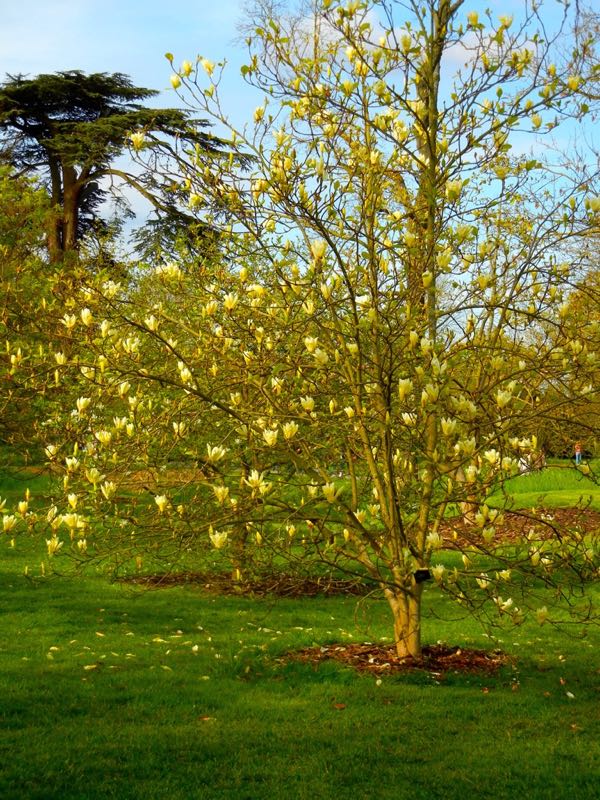

A triploid, probably from a Phil Savage cross between M. Distributed on both sides of the Atlantic, and highlighted as an up-and-coming variety in Europe by Williams, Gardiner & Gallagher (2016). It has a low canopy with a typical clearance of 3 feet from the ground, and is suitable for planting under power lines. Yellow Lantern Magnolia will grow to be about 20 feet tall at maturity, with a spread of 15 feet. ‘Daybreak’), the tepals quickly drooping to reveal their creamy inner surfaces. Yellow Lantern Magnolia is recommended for the following landscape applications Accent General Garden Use Planting & Growing. ‘Yuchelia’ : Flowering with or just before the new leaves, strongly scented tepals rose-pink outside (rather resembling M. doltsopa) Little known and poorly documented, although at least one clone from this 1980s Phil Savage cross was sold in the 1990s as ‘Moonchimes’ by Louisiana Nurseries.

Charles Williams notes that he would doubt that it had any input from M. Raised by Phil Savage, MI in the 1980s, and now in collections on both sides of the Atlantic. acuminata parent, but with the outer tepals less strongly reduced yellow inner tepals flowers after leaf emergence. Yellow Lantern Cucumber Magnolia (Magnolia acuminata 'Yellow Lantern'): Yellow Lantern magnolia features fragrant yellow tulip-shaped blooms on a small to medium tree with a compact habit. Ultimately, ‘Yuchelia’ should probably not be used as a cultivar name at all. Until the situation has been resolved, we follow Lobdell (2021) in tagging them informally as follows. The name was first used by Phil Savage ( 1989), who probably did not intend it as a cultivar name. This particular variety is an interspecific hybrid.A problematic name which cannot be ignored: it has been used for at least three different selections or groups claimed as hybrids between members of Sections Magnolia and Yulania ( Lobdell 2021). The flowers are upright and tulip-shaped. acuminata is on of the parents, Magnolia x 'Yellow Lantern' is a relatively small ornamental tree. Consider applying a thick mulch around the root zone in winter to protect it in exposed locations or colder microclimates. 'Yellow Lantern' Magnolia has very large lemon-yellow flowers which appear in late spring and last for a long time. It is quite intolerant of urban pollution, therefore inner city or urban streetside plantings are best avoided. It is not particular as to soil type, but has a definite preference for acidic soils. It requires an evenly moist well-drained soil for optimal growth, but will die in standing water.
MAGNOLIA YELLOW LANTERN TREE FULL
This tree does best in full sun to partial shade. It grows at a medium rate, and under ideal conditions can be expected to live for 50 years or more. The blooms are borne on leafless branches, since they emerge before the new leaves begin to unfurl. across (13 cm), is tinged rosy-pink at the base.

Yellow Lantern Magnolia will grow to be about 20 feet tall at maturity, with a spread of 15 feet. Magnolia 'Solar Flair' is a deciduous tree with masses of upright, deep yellow flowers in early spring.

Fragrant, tulip-shaped, creamy yellow flowers (. Yellow Lantern Magnolia is recommended for the following landscape applications It typically grows as an upright, single-trunked, pyramidal to oval tree that matures over time to 25-30 tall. It has no significant negative characteristics. This is a relatively low maintenance tree, and should only be pruned after flowering to avoid removing any of the current season's flowers. Its relatively coarse texture can be used to stand it apart from other landscape plants with finer foliage. Yellow Lantern Magnolia is a deciduous tree with a strong central leader and an upright spreading habit of growth. The large pointy leaves turn coppery-bronze in fall. Yellow Lantern Magnolia is smothered in stunning fragrant lemon yellow cup-shaped flowers with tan overtones held atop the branches in mid spring before the leaves. A hybrid magnolia which is bathed in large creamy yellow flowers in spring upright habit of growth with a central leader and large, coarse leaves an excellent specimen tree, best located where its flowers can be appreciated close-up


 0 kommentar(er)
0 kommentar(er)
